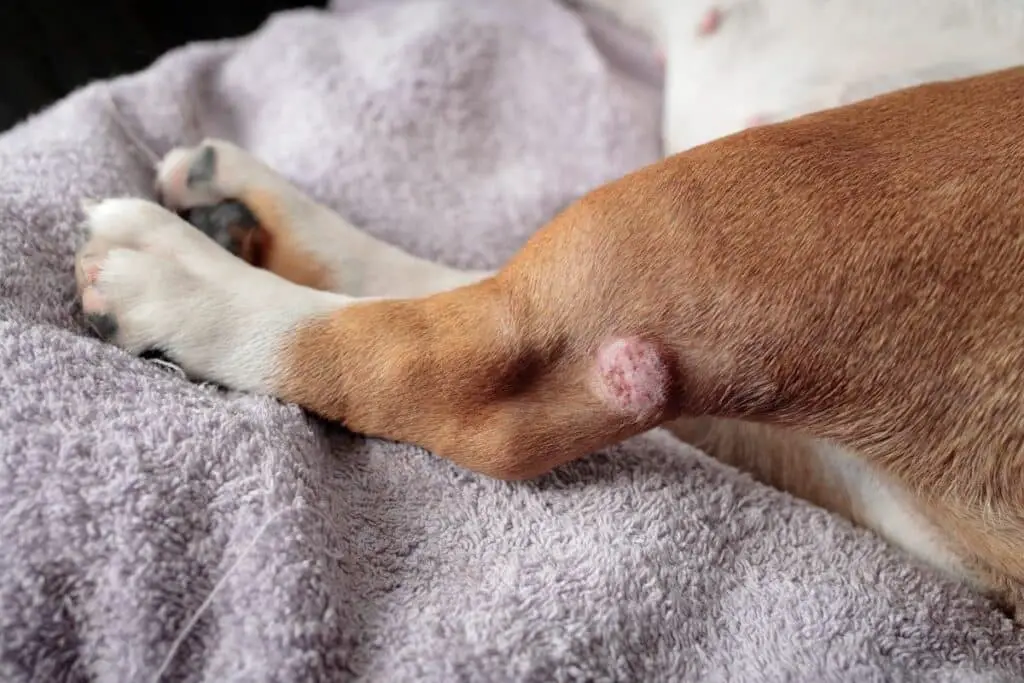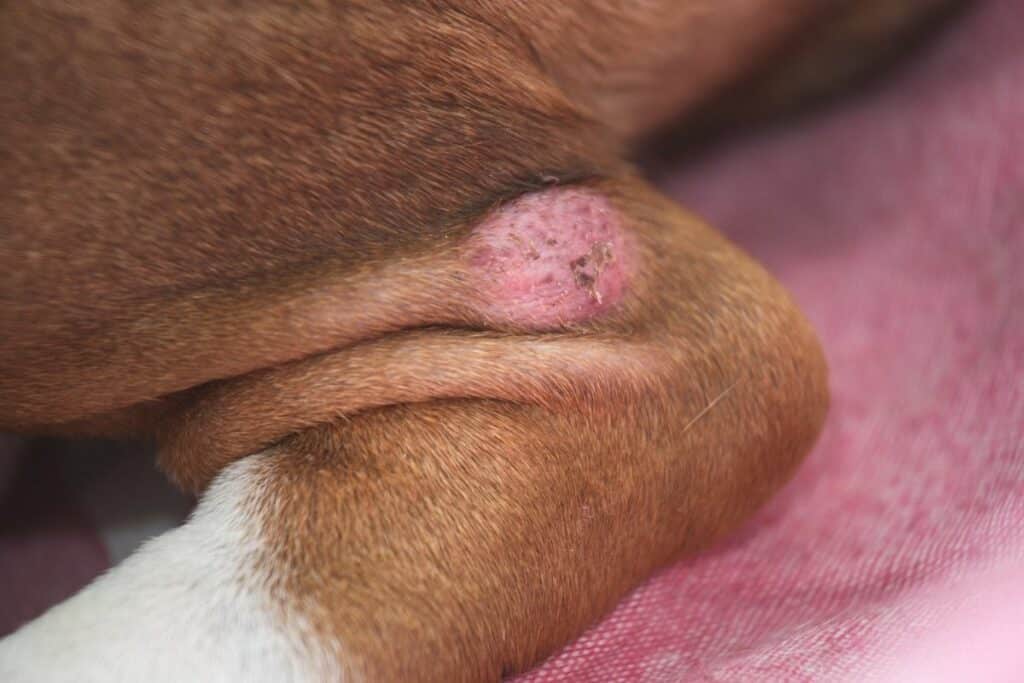Unfortunately, there is no clear answer as to what the bump is on your dog’s leg as it could be a number of things but by reading this guide, you might get an idea of what it might be which will help you describe the condition to the vet.
Bumps that are found on dogs’ legs can range in size, texture, mobility, and color but for now, we will talk about the bumps that are usually red.

It will also be discussed in detail as to what the different causes are, how it is treated, and the prognosis for your best four-legged friend.
Skin Tag
We will begin this list with something that is not serious and if anything is just a bit weird to look at. When humans get older, we also tend to develop what are called skin tags which are essentially fibrous growths that grow from the skin on a little stalk.
They can look a bit like warts and don’t typically have any hair on them which makes them relatively easy to spot.
They are completely harmless but can sometimes get caught on things or obstruct vision which is why some decide to remove them, which can be said the same for dogs.
Skin tags typically appear on the legs, chest, and face of dogs and are not limited to any breed of dog but are found to be more common on large dogs for a reason that we are not too sure about yet.
Treatment
As mentioned before, you can get the skin tag removed if you find that it is negatively affecting your dog’s quality of life. If the skin tag or tags are in locations such as on the paws and underneath the collar, they might get irritated and inflamed which is a viable reason to get them removed.
Do not attempt to remove skin tags by yourself because it will only put your dog through unnecessary stress and pain. Taking them to a vet is the best way to go as they have all the proper equipment to get it done quickly with as little pain as possible.
Pressure Sore
Pressures sores look like pink callouses that are usually found on dogs’ elbows. It is caused by repeated trauma to the area of skin which constricts the blood vessels and therefore decreases the supply of blood.
When we say trauma, it is not as dramatic as it sounds as trauma can simply be from the dog lying down on a hard floor every day for many years which is why pressure sores are mostly seen in older dogs.
Dogs that are large or overweight are more likely to get pressure sores on their elbows as more force is being applied to them. However, skinny dogs are also more prone to them as they do not have enough adequate padding on their joints that come into contact with the ground.
Pressure sores are mostly harmless, but you should be very careful if your dog has issues with its immune system as the area around pressure sores can get infected. Sometimes the dog will lick their pressure sores which can make them irritated and inflamed.
In some cases, if the condition is not managed, the pressure sores can turn into a hygroma which is when the area swells up with fluid and has a thick lump of fibrous tissue underneath the skin. They may look a bit scary but hygroma is not usually painful.
Treatment
Once a pressure sore has developed, it is almost impossible to get rid of them so that is why the most important thing to do is prevent it from happening in the first place.
To do this, make sure that your dog has one or two soft, comfortable beds to lie on in different rooms so that they don’t have to lie on the hard ground.
Some dogs like to lie on the kitchen floor for example to help cool down, but there are suspended beds that you can get that are soft and will cool them down in the same way. Encourage your dog to use these soft places to lie instead of the floor by giving them lots of praise and treats when they choose the bed over the ground.
Having said this, dogs will lie on the ground sometimes, and that’s okay because it’s natural for them to lie wherever and if they do it sometimes for short periods of time, they won’t develop pressure sores.
Another way to prevent pressure sores is by keeping your dog’s weight under control which goes both ways as being too skinny or too overweight will play a part in pressure sores.
Abscess
There are a few things that can cause abscesses, but they all take the same form which is essentially a pocket of pus. It is underneath the skin and when you touch it, it will be squishy, swollen, and your dog will likely wince in pain, so you must be gentle.
Your dog might try to lick the abscess a lot as they are finding it painful and are trying to make it better, but this can lead to it getting irritated. Sometimes some discharge will leak out of the abscess, but you shouldn’t take this as a sign to squeeze it as it can lead to more infection and a big mess.
Abscesses are the body’s reaction to trauma and infection which can come from a bite wound, insect bite, ingrown hair, grass seed, or something else.
Treatment
To treat an abscess, you need to take your dog to the vet so that they can deduce what has caused it. Then they will drain the pus and blood from it (which usually smells very bad), before flushing it out with water and a sterile solution.
Finally, they will prescribe your dog a course of antibiotics to help them fight the infection which will stop the body from making another abscess.

Sebaceous Cyst
A sebaceous cyst is essentially a blocked oil gland that is very similar to a big pimple that we all know and love. If you run your finger along the surface of it, you will feel a raised lump that may have a white head as well.
Even though they can become irritated and sore, they are not harmful to your dog, and they might burst once it reaches a certain point which will secrete pus and blood.
Treatment
Most of the time, a sebaceous cyst will go away on its own, either by bursting and draining or shrinking back down completely.
When the cyst goes away, there is a chance that it will come back but if it keeps coming back or is getting too painful for your dog, then take them to the vet to get it seen.
Hives
Hives that appear on us humans are the same as the ones that can appear on your dog. It takes the form of a rash consisting of lots of little red bumps. Your dog will find the hives very itchy and if they keep scratching them, the hives will get even redder and more inflamed.
Hives are caused by an allergic reaction to something that the dog has come into contact with which could either be something that they have ingested, walked past, or from pollen that is in the air. It could also be due to an insect bite or sting such as from a bee and your dog is having an allergic reaction.
Treatment
If it is a mild case of hives, they will usually go away on their own without any medical intervention, but you should keep an eye on your dog just in case the reaction gets worse or spreads to other parts of the body.
You should take your dog to the vet if the hives are particularly aggressive, do not go away after 24 hours, or your dog’s face is swelling up and obstructing its breathing.
Lipoma
Lipoma is quite a common lump found on the legs of older dogs and is a natural part of getting old. They are fat-filled tumors that are underneath the skin and should feel rounded, soft, and not painful for your dog.
Dogs that are overweight are more prone to developing lipoma lumps because they have more fatty deposits.
Treatment
Sometimes they can be a bit red if they are in a location that is getting irritated when the dog walks, lies down, or is underneath their collar. In these cases, your vet will likely recommend that you get them removed so that your dog is more comfortable.
Histiocytoma
These lumps look like little red buttons that are usually found on dogs that are aged less than six years old. They typically go away on their own and are not harmful as they are an overgrowth of immune system cells that are used for protecting the skin from cancer.
Sometimes, histiocytoma can be mistaken for certain types of cancers and vice versa which is why if you see one of these lumps on your dog, you should take them to the vet to diagnose the cause to know for sure.
Treatment
If the histiocytoma does not go away on its own, you might be advised to get it surgically removed especially if it is getting in the way of your dog’s daily life or is causing them to lick it out of irritation.
Most of the time, the removal of a histiocytoma is done under a local anesthetic, but this depends on where it is located on the body, the size, and the temperament of the dog.
Cancerous Tumor
This is the worst-case scenario of what that red lump is on your dog’s leg. Tumors can take different shapes and sizes depending on how long it has been there for, the type of cancer, and how aggressive it is.
If you have looked at the previous lumps and what they look like but none of them resonate with what you are seeing on your dog, then you should take them to get a biopsy which is where the vet takes a small sample and runs tests to find out what kind of tumor it is and whether it is cancerous or benign.
Summary
Dogs can get a lot of lumps and bumps coming and going all throughout their lives, but some of them can look particularly scary.
This is why you should act fast when you first see one popping up on your dog so that you can catch it as early as possible, potentially saving your dog’s life if it is something such as cancer.
- What Dog Breeds Have Pink Skin? - March 24, 2023
- What Are the Most Inspiring Dog Breeding Quotes? - March 20, 2023
- Can Pheromone Spray Help Improve Dog Breeding Results? - March 19, 2023








